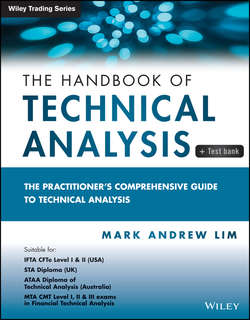Читать книгу The Handbook of Technical Analysis + Test Bank - Lim Mark Andrew - Страница 25
На сайте Литреса книга снята с продажи.
CHAPTER 2
Introduction to Dow Theory
2.3 CHALLENGES TO DOW THEORY
ОглавлениеThere are many criticisms of Dow Theory. Here are some of the more significant arguments against it:
1. Dow Theory is more applicable to the equity markets: Detractors of Dow Theory argue that the theory is unsuitable for application in faster moving markets or across lower timeframes. For example, a commodity trader would have to wait for months and maybe even years for a buy or sell signal based on the penetration of a previous peak or trough in the primary bull or bear trend. Hedgers would have few or no counterparties to take the other side of the trade. Furthermore, the capital risk would be astronomically high if the trader is expected to place a stop loss order based on the motion of the primary trend.
2. The primary trend is susceptible to manipulation: Monetary policy such as near-zero interest rates set by central banks over extended periods combined with colossal stimulus packages and quantitative-easing (QE) – to-infinity-type operations impact the longer-term action of the markets by creating an artificially super bullish environment where even its participants have little or no fear of anything untoward happening to the markets. Collective energy market rigging and the latest Libor scandal are further evidence that markets have and will always be susceptible to manipulation. Hence, Dow’s main reason for trading the primary trend is questionable in today’s highly impacted markets.
3. The averages are not a true reflection and barometer of the market environment: Unfortunately, in today’s markets, the majority of indices are themselves tradable and are therefore open to manipulation. For example, the VIX was meant to reflect the level of fear in the markets. It main objective is somewhat thwarted by the large amount of speculative trading impacting the VIX. Physical gold prices are also at the mercy of heavy shorting in its corresponding ETFs, like the GLD, or via its futures and options contracts. Such products never existed in Dow’s time.
4. Only closing prices are recognized: Recognizing only the closing price ignores potentially large intraday ranges that may occur during the day’s trading session. These important price rejection levels are totally disregarded. Furthermore, there seems to be some conceptual conflict between recognizing the smallest amount required to close higher or lower while at the same time discounting potentially large and significant day to day fluctuations, regarding them as merely noise.
5. The buy and sell signals based on the primary trend are safer: This may or may not be true, but detractors of Dow Theory argue that such signals usually occur late in the trend and miss a large part of it.
6. The identification of a new primary trend: Due to the difficulty in establishing whether a retracement is part of a secondary reaction or the inception of a new primary trend in the opposite direction, investments based on the belief that the retracement is merely a secondary reaction will run a higher risk of losing capital should the market unfold contrary to what was expected.
7. The averages must confirm each other: The rationale behind this logic is that in a healthy economy, the goods produced by industry are in great demand and this is evidenced by the amount of transport activity generated in trying to ship these goods to the consumers. Therefore, underperformance in either the industrial or transportation averages leading to non-confirmation would logically signal potential trouble in the economy. Unfortunately, the Dow Jones Industrial Average today is composed of many stocks that do not produce any physical product that requires shipping or transport, in general. Many of today’s companies are more involved in financial products, telecommunications, and insurance. This severely diminishes the effectiveness of confirmation between the industrials and the transports. Many practitioners today prefer to look for confirmation between large cap and smaller cap indices like the S&P500 and Russell 2000 as a more reliable barometer of market action.
